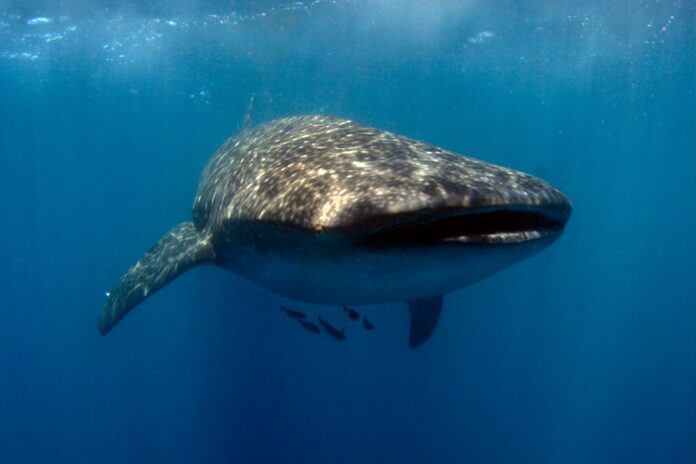Recently, we dove deep on the world’s smallest shark (the dwarf lanternshark) and now we’re swinging to the other end of the shark size spectrum to look at the world’s largest fish. The whale shark is the only lying species of the genus Rhincodon and the largest living shark. In fact, it’s one of the largest animals on the planet, outsized only by some whales.
The average whale shark measures about 30 feet long, with a mouth stretching nearly 5-feet across. The largest whale sharks are twice that size, stretching a staggering 60 feet from tip to tail. These gentle giants swim in tropical waters all over the world, gobbling up plankton and other tiny sea creatures with their gaping maws. They regularly dive several thousand feet beneath the water’s surface and migrate thousands of miles at a sedate rate of about 3 miles per hour. And that’s just the beginning of what makes whale sharks cool.
Whale sharks use their teeth in weird and unexpected ways
Sharks are known for their teeth. Shark teeth are sharp, and they have a lot of them, laid out in row after row inside a shark’s mouth. Over time, the teeth in front fall out, only to be replaced by a shiny new set. The identities of sharks are so intertwined with their teeth that when Peter Benchley wrote his landmark 1974 novel, he titled it simply Jaws.
Whale sharks have teeth, but they don’t use them the way other sharks do. Inside a whale shark’s mouth, you’ll find more than 300 rows of tiny teeth, but they don’t use them to eat (more on that in a minute). Some shark scientists have suggested they are vestigial, evolutionary leftovers from differently adapted ancestors.
While whale sharks don’t use the teeth in their mouths, they do use the teeth in their eyes. A whale shark’s eyes are covered in tooth-like structures called dermal denticles. Each eye has more than 3,000 tiny teeth clustered around the iris which scientists believe are used to protect the eye from damage. A 2020 study published in the journal PLOS One also showed that whale sharks can retract their eyeball into the eye socket. Because sharks have no eyelids and their eyes stick out from either side of the head, retractable armor-plated eyes seem to be important features for a whale shark’s survival.
Becoming the world’s largest shark takes a lot of food, here’s how whale sharks eat
Whale sharks get their name both from their whale-like appearance and from how they hunt. Like baleen whales (a group which includes humpback whales, blue whales, gray whales, and others), whale sharks feed by taking in large amounts of water and filtering tiny food particles out of it.
Unlike most sharks, a whale shark’s mouth is positioned at the front of the head, rather than underneath and slightly back. Five large gill slits are positioned on either side of the head, each featuring spongy filter pads which trap food particles as water passes through. It’s one of only three known species of filter-feeding sharks, alongside megamouth sharks and basking sharks. Whale sharks can pass more than 1,500 gallons of water per hour through their filter pads, trapping and eating krill, crab and fish larva, small fish, and jellyfish in the process.
Whale sharks and baleen whales are all filter feeders, but they filter their food in different ways. Baleen whales have long strand-like teeth hanging from the upper jaw, forming baleen plates. As water flows through the plates, krill, zooplankton, and other small critters get trapped. Then the whale licks the plates and swallows. By contrast, whale sharks slow to a stop and suck water into their mouths. Instead of baleen, food gets trapped in the filtering pads. Every once in a while, the shark closes its mouth to swallow.
There’s a lot we still don’t know about whale sharks
Whale sharks reach maturity at about 30 years old and can live for 100 years or longer. In the same way that humans have unique fingerprints, each whale shark is covered in a unique pattern of spots and stripes.
Female whale sharks grow eggs which develop inside their bodies, allowing them to give birth to live young. Litters can have more than 300 individuals but they won’t necessarily be born at the same time. Instead, a female whale shark may hold sperm in reserve, developing offspring in batches, allowing them to produce a steady flow of offspring over time. Still, it’s estimated that fewer than 10% of juvenile whale sharks survive to adulthood.
Because whale sharks spend so much time in the open ocean and at incredible depths, not much else is known about their daily lives. We’re just glad these gentle giants are part of our ocean ecosystem, no matter what they’re doing out there.
Celebrate sharks (even the angry ones) with a rewatch of Jaws, streaming now on Peacock!








